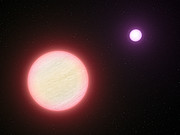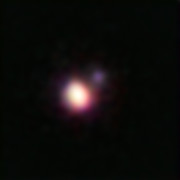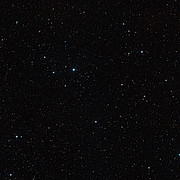Persbericht
Een zeer koel tweetal bruine dwergen
23 maart 2011
Waarnemingen met de Very Large Telescope van de Europese Zuidelijke Sterrenwacht en twee andere telescopen hebben een nieuwe kandidaat opgeleverd voor de titel ‘koudst bekende ster’. Het gaat om een bruine dwerg in een dubbelstersysteem die ongeveer zo heet is als een vers kopje thee. Naar menselijke maatstaven is dat aardig heet, maar voor een ster is het buitengewoon koud. Door ontdekkingen als deze vervaagt de grens tussen kleine, koele sterren en grote, hete planeten.
Bruine dwergen zijn feitelijk mislukte sterren. Ze hebben te weinig massa om de zwaartekracht in staat te stellen om de kernreacties op gang te brengen die sterren laten stralen. De nu ontdekte bruine dwerg, die de aanduiding CFBDSIR 1458+10B draagt, is de zwakste van een tweetal om elkaar draaiende bruine dwergen. Deze koele dubbelster is slechts 75 lichtjaar van ons verwijderd [1].
Om aan te tonen dat de dubbelster zelfs voor een bruine dwerg erg koel is, werd de X-shooter-spectrograaf van ESO’s Very Large Telescope (VLT) ingezet. ‘We waren erg verrast dat dit object zo’n lage temperatuur heeft, maar nog meer door het feit dat het een dubbelster bleek te zijn met een nóg interessantere component die zelfs nog kouder is,’ zegt Philippe Delorme van het Institut de planétologie et d’astrophysique de Grenoble (CNRS/Université Joseph Fourier), co-auteur van het wetenschappelijke artikel. CFBDSIR 1458+10 is de koelste dubbele bruine dwerg die tot nog toe is opgespoord.
De zwakste van de beide dwergen blijkt een oppervlaktetemperatuur te hebben van ongeveer 100 graden Celsius – het kookpunt van water, en niet veel hoger dan de temperatuur in een sauna [2]. ‘Bij zulke temperaturen verwachten we dat de bruine dwerg andere eigenschappen heeft dan eerder ontdekte bruine dwergen en veel meer op een reuzenplaneet lijkt – hij zou zelfs wolken waterdamp in zijn atmosfeer kunnen hebben,’ aldus Michael Liu van het Institute for Astronomy van de universiteit van Hawaï, die de hoofdauteur is van het artikel waarin dit nieuwe onderzoek wordt beschreven. ‘Sterker nog, als we in de nabije toekomst foto’s gaan maken van grote gasplaneten bij zonachtige sterren, zullen vele daarvan volgens mij op CFBDSIR 1458+10B lijken.’
Bij het ontrafelen van de eigenschappen van dit unieke object is gebruik gemaakt van drie verschillende telescopen. Dat CFBDSIR 1458+10 een dubbelster is, werd ontdekt met het Laser Guide Star (LGS) adaptieve optische systeem van de Keck II-telescoop op Hawaï [3]. Liu en zijn collega’s hebben vervolgens de Canada-France-Hawaii-telescoop, eveneens op Hawaï, ingezet om met behulp van een infraroodcamera de afstand van de bruine dwerg te bepalen [4]. Ten slotte werd ESO’s VLT gebruikt om het infraroodspectrum van het object te onderzoeken en zijn temperatuur te meten.
De jacht op koele objecten is momenteel een hot topic in de astronomie. De Spitzer-ruimtetelescoop heeft onlangs twee andere zeer zwakke objecten ontdekt die meedingen naar de titel ‘koelste bruine dwerg’, al zijn hun temperaturen nog niet zo nauwkeurig gemeten. Toekomstige waarnemingen moeten uitwijzen hoe deze objecten zich verhouden tot CFBDSIR 1458+10B. Liu en zijn collega’s zijn van plan om CFBDSIR 1458+10B nogmaals te bekijken – niet alleen om meer inzicht te krijgen in zijn eigenschappen, maar ook om de baanbeweging van de dubbelster in kaart te brengen. Dat laatste zal astronomen binnen een jaar of tien in staat stellen om de massa’s van de beide sterren te bepalen.
Noten
[1] CFBDSIR 1458+10 is de naam van het dubbelstersysteem. De beide componenten heten CFBDSIR 1458+10A en CFBDSIR 1458+10B, waarbij de laatste de zwakste van de twee is. Het lijkt erop dat ze met een periode van ongeveer dertig jaar om elkaar heen draaien op een afstand die minder dan drie keer zo groot is als de afstand aarde-zon.
[2] Ter vergelijking: het oppervlak van de zon heeft een temperatuur van ongeveer 5500 graden Celsius.
[3] Adaptieve optiek heft de vertroebelende invloed van de aardatmosfeer voor een groot deel op, waardoor de beeldscherpte met een factor tien verbetert en nauwe dubbelsterren als deze opgelost kunnen worden.
[4] Om de afstand van de bruine dwergen te bepalen, hebben de astronomen hun schijnbare beweging ten opzichte van de achtergrond van verder weg gelegen sterren gemeten. Deze beweging, die parallax wordt genoemd, wordt veroorzaakt door de veranderende positie van de aarde in haar omloopbaan om de zon.
Meer informatie
De resultaten van dit onderzoek staan beschreven in het artikel ‘CFBDSIR J1458+1013B: A Very Cold (>T10) Brown Dwarf in a Binary System’, van Liu et al., dat in de Astrophysical Journal zal verschijnen.
Het onderzoeksteam bestond uit Michael C. Liu (Institute for Astronomy [IfA], University of Hawaii, VS), Philippe Delorme (Institut de planétologie et d’astrophysique de Grenoble, CNRS/Université Joseph Fourier, Frankrijk [IPAG]), Trent J. Dupuy (Harvard-Smithsonian Center for Astrophysics, Cambridge, NS), Brendan P. Bowler (IfA), Loic Albert (Canada-France-Hawaii Telescope Corporation, Hawaii, VS), Etienne Artigau (Université de Montréal, Canada), Celine Reylé (Observatoire de Besançon, Frankrijk), Thierry Forveille (IPAG) and Xavier Delfosse (IPAG).
ESO, de Europese Zuidelijke Sterrenwacht, is de belangrijkste intergouvernementele sterrenkundeorganisatie in Europa, en het meest productieve astronomische observatorium ter wereld. ESO wordt ondersteund door 15 landen: België, Brazilië, Denemarken, Duitsland, Finland, Frankrijk, Italië, Nederland, Oostenrijk, Portugal, Spanje, Tsjechië, het Verenigd Koninkrijk, Zweden en Zwitserland. ESO voert een ambitieus programma uit, gericht op het ontwerp, de bouw en het beheer van krachtige grondobservatoria die astronomen in staat stellen om belangrijke wetenschappelijke ontdekkingen te doen. ESO speelt ook een leidende rol bij het bevorderen en organiseren van samenwerking op sterrenkundig gebied. ESO beheert drie waarnemingslocaties van wereldklasse in Chili: La Silla, Paranal en Chajnantor. Op Paranal staat ESO’s Very Large Telescope (VLT), de meest geavanceerde optische sterrenwacht ter wereld. Ook is ESO de Europese partner van de revolutionaire telescoop ALMA, het grootste sterrenkundige project van dit moment. Daarnaast bereidt ESO momenteel de bouw voor van de 42-meter Europese Extremely Large optische/nabij-infrarood Telescoop (E-ELT), die ‘het grootste oog op de hemel’ ter wereld zal worden.
Links
Contact
Michael Liu
Institute for Astronomy, University of Hawaii
USA
Tel: +1 808 956 6666
E-mail: mliu@ifa.hawaii.edu
Philippe Delorme
Institut de planétologie et d’astrophysique de Grenoble
France
Tel: +33 4 76 63 58 30
E-mail: Philippe.Delorme@obs.ujf-grenoble.fr
Christian Veillet
Executive Director, CFHT, Hawaii
USA
Tel: +1 808 885 7944
E-mail: veillet@cfht.hawaii.edu
Richard Hook
ESO, La Silla, Paranal, E-ELT and Survey Telescopes Press Officer
Garching bei München, Germany
Tel: +49 89 3200 6655
E-mail: rhook@eso.org
Rodrigo Alvarez (press contact België)
ESO Science Outreach Network
en Planetarium, Royal Observatory of Belgium
Tel: +32-2-474 70 50
E-mail: eson-belgië@eso.org
Over dit bericht
| Persberichten nr.: | eso1110nl-be |
| Naam: | CFBDSIR 1458+10 |
| Type: | Milky Way : Star : Type : Brown Dwarf |
| Facility: | CFHT, New Technology Telescope, Very Large Telescope, W. M. Keck Observatory |
| Instruments: | SOFI, X-shooter |
| Science data: | 2011ApJ...740..108L |
Our use of Cookies
We use cookies that are essential for accessing our websites and using our services. We also use cookies to analyse, measure and improve our websites’ performance, to enable content sharing via social media and to display media content hosted on third-party platforms.
ESO Cookies Policy
The European Organisation for Astronomical Research in the Southern Hemisphere (ESO) is the pre-eminent intergovernmental science and technology organisation in astronomy. It carries out an ambitious programme focused on the design, construction and operation of powerful ground-based observing facilities for astronomy.
This Cookies Policy is intended to provide clarity by outlining the cookies used on the ESO public websites, their functions, the options you have for controlling them, and the ways you can contact us for additional details.
What are cookies?
Cookies are small pieces of data stored on your device by websites you visit. They serve various purposes, such as remembering login credentials and preferences and enhance your browsing experience.
Categories of cookies we use
Essential cookies (always active): These cookies are strictly necessary for the proper functioning of our website. Without these cookies, the website cannot operate correctly, and certain services, such as logging in or accessing secure areas, may not be available; because they are essential for the website’s operation, they cannot be disabled.
Functional Cookies: These cookies enhance your browsing experience by enabling additional features and personalization, such as remembering your preferences and settings. While not strictly necessary for the website to function, they improve usability and convenience; these cookies are only placed if you provide your consent.
Analytics cookies: These cookies collect information about how visitors interact with our website, such as which pages are visited most often and how users navigate the site. This data helps us improve website performance, optimize content, and enhance the user experience; these cookies are only placed if you provide your consent. We use the following analytics cookies.
Matomo Cookies:
This website uses Matomo (formerly Piwik), an open source software which enables the statistical analysis of website visits. Matomo uses cookies (text files) which are saved on your computer and which allow us to analyze how you use our website. The website user information generated by the cookies will only be saved on the servers of our IT Department. We use this information to analyze www.eso.org visits and to prepare reports on website activities. These data will not be disclosed to third parties.
On behalf of ESO, Matomo will use this information for the purpose of evaluating your use of the website, compiling reports on website activity and providing other services relating to website activity and internet usage.
Matomo cookies settings:
Additional Third-party cookies on ESO websites: some of our pages display content from external providers, e.g. YouTube.
Such third-party services are outside of ESO control and may, at any time, change their terms of service, use of cookies, etc.
YouTube: Some videos on the ESO website are embedded from ESO’s official YouTube channel. We have enabled YouTube’s privacy-enhanced mode, meaning that no cookies are set unless the user actively clicks on the video to play it. Additionally, in this mode, YouTube does not store any personally identifiable cookie data for embedded video playbacks. For more details, please refer to YouTube’s embedding videos information page.
Cookies can also be classified based on the following elements.
Regarding the domain, there are:
- First-party cookies, set by the website you are currently visiting. They are stored by the same domain that you are browsing and are used to enhance your experience on that site;
- Third-party cookies, set by a domain other than the one you are currently visiting.
As for their duration, cookies can be:
- Browser-session cookies, which are deleted when the user closes the browser;
- Stored cookies, which stay on the user's device for a predetermined period of time.
How to manage cookies
Cookie settings: You can modify your cookie choices for the ESO webpages at any time by clicking on the link Cookie settings at the bottom of any page.
In your browser: If you wish to delete cookies or instruct your browser to delete or block cookies by default, please visit the help pages of your browser:
Please be aware that if you delete or decline cookies, certain functionalities of our website may be not be available and your browsing experience may be affected.
You can set most browsers to prevent any cookies being placed on your device, but you may then have to manually adjust some preferences every time you visit a site/page. And some services and functionalities may not work properly at all (e.g. profile logging-in, shop check out).
Updates to the ESO Cookies Policy
The ESO Cookies Policy may be subject to future updates, which will be made available on this page.
Additional information
For any queries related to cookies, please contact: pdprATesoDOTorg.
As ESO public webpages are managed by our Department of Communication, your questions will be dealt with the support of the said Department.




